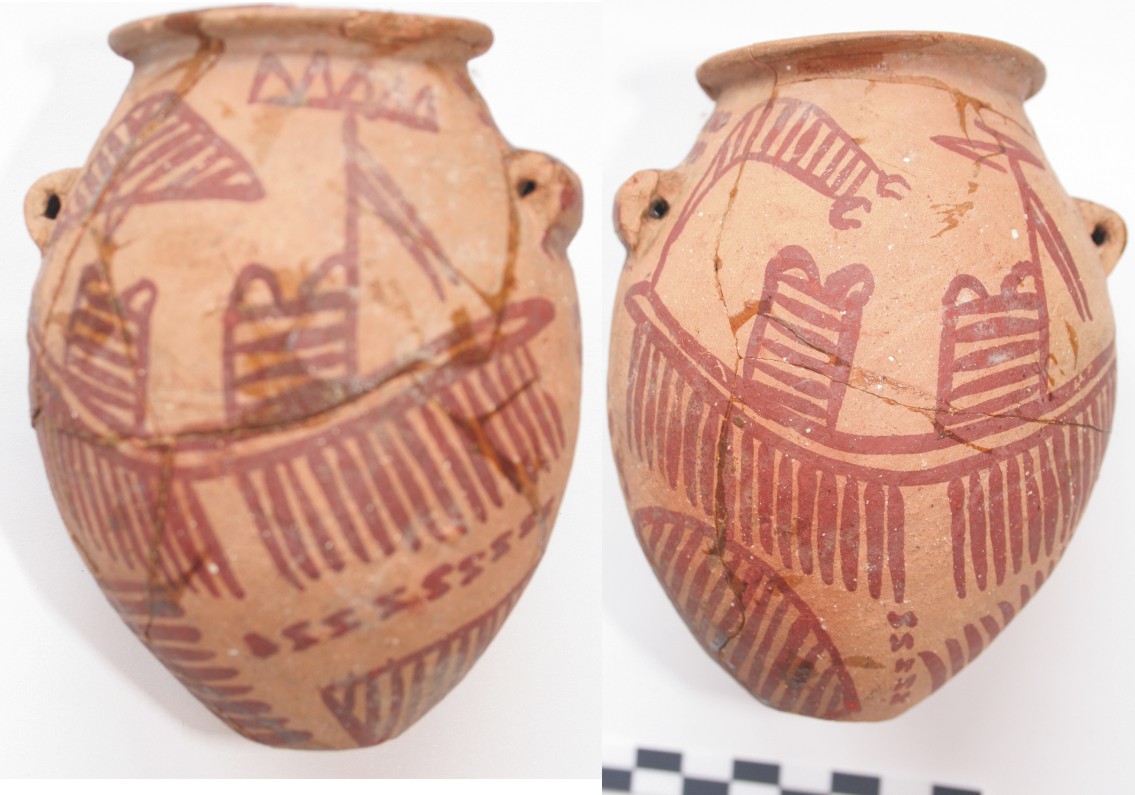W5308
{loadposition share}
W5308
 This type of pottery is called ‘D-ware’ or ‘Decorated Ware’. These pots date from about 3500 BC but the earliest Egyptian pots date to around 5500 BC!
This type of pottery is called ‘D-ware’ or ‘Decorated Ware’. These pots date from about 3500 BC but the earliest Egyptian pots date to around 5500 BC!
Pottery vessels such as these date to the Naqada II period and are found throughout Egypt. They are rare on settlement sites and not as frequent in graves as other types of pottery. It has been suggested that they were meant to convey the idea of a continued spiritual life in a Nile environment, or they may be a means of producing spells for the afterlife.
The meaning of the patterns on the vessels is debatable. Most egyptologists now agree that the type of decoration shown here shows a boat bearing a standard or banner. It used to be said that such representations are not boats but watered land with a chief’s residence, or a temple platform on stilts. The standards on poles are usually accepted as divine emblems or signs of clans or nomes. Some of the signs on other pots are almost identical with those of gods in historic times. The scattered ‘zzzz’ signs have been variously interpreted as numbers, libation water, birds or notations of weight and the blocked triangles as hills. The motifs were not only common on pottery of this period but also occur in the earliest known example of Egyptian wall painting, a painted tomb at Hierakonpolis.
Some other D-ware vessels have animals such as gazelles upon them or human figures, such as woman with arms raised above her head (possibly in prayer or dance).
Such pots are made of marl clay. Marl clay, found on the desert edge, and under the cultivation near the desert was used. Pottery of this date is shaped by coiling and smoothing (you can see the coiling on the inside of the vessel.) The decoration was applied before firing. Brushes were made from reeds and the paint from oxides of iron.
The fact that these vessels do not have a flat base shows that they were put in potholders, or suspended by a cord, or placed in the sand to stay upright. The lug type handles might suggest that they were suspended when in use. The lugs might alternatively have been used to tie on a cloth lid. Unfortunately we do not know what was in them. Since they are quite small they may have contained an expensive commodity.
For an overview of ideas on the origins of D-ware see Askamit (1998, 36-37). The current opinion is that D-ware originates in Upper Egypt in the Naqada-Abydos area.
This artefact is illustrated in the MacGregor Sotheby sale catalogue 1922 pl. LIII. The artefact fits the description for lot 1757, ‘the smaller with a two-cabined boat on each side; found opposite Gebelein’.
Other items from Gebelein in the Egypt Centre
Other examples of D-ware in the Egypt Centre
Other Predynastic and Early Dynastic items in the Egypt Centre
Further Reading
Adams, B. 1988. Predynastic Egypt. Oxford: Shire Publications.
Askamit, J. 1998. The D ware from Abusir el-Meleq. In C.J. Eyre ed. Proceedings of the Seventh International Congress of Egyptologists’, Cambridge, 3-9 September 1995. Leuven: Uitgeverij Peeters, 31-38.
Arnold, D. and Bourriau, J.D. 1993. An Introduction to Ancient Egyptian Pottery. Mainz: Philipp von Zabern.
Hope, C. 1987. Egyptian Pottery. Oxford: Shire Publications